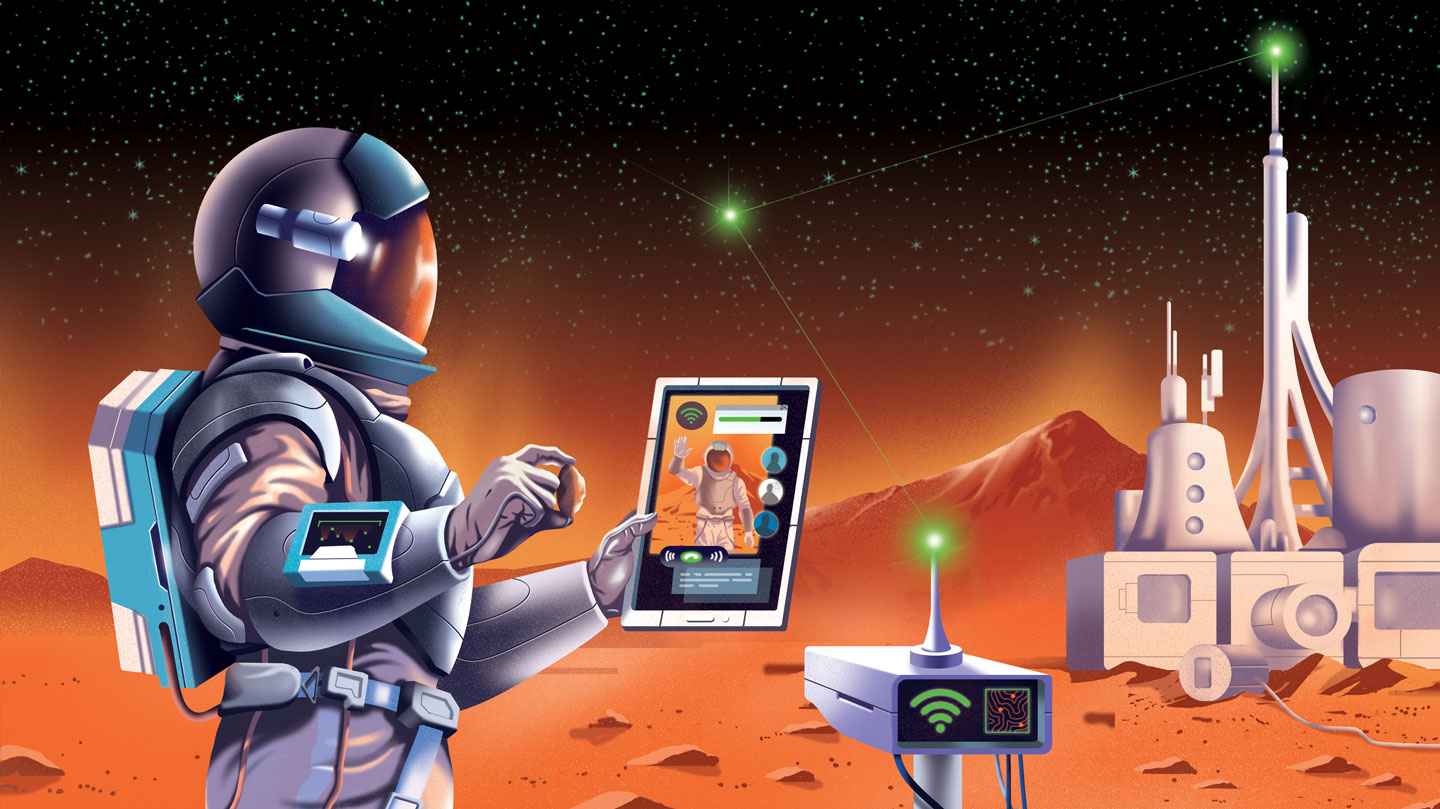Creating an Internet Infrastructure on Mars

When astronauts do eventually get to Mars, possibly in a couple of decades' time, they are going to need a form of communication. This communication needs to extend to one another, any equipment on and orbiting the planet and, of course, mission control back on Earth. Their distance from home will demand a connection that allows them to keep in touch with loved ones, update their music playlists, or stream their favorite shows.
Unfortunately, creating a Wi-Fi connection that connects to Earth's internet is not feasible. With a distance ranging from approximately 55 million to 400 million kilometers between the two planets, depending on their positions in their orbits, astronauts are going to require a different solution.
Considering human missions to Mars, it is crucial to have a robust communications infrastructure, according to Claire Parfitt, a systems engineer with the European Space Agency (ESA) who currently resides in Noordwijk, Netherlands. She reveals that work has started in exploring what that entails.
Scientists are currently exploring the enhancement of existing networks as well as more radical alternatives. An example is NASA’s Psyche mission, which launched in October with the goal of studying an asteroid positioned between Mars and Jupiter. This mission will also test interplanetary communication utilizing lasers, which are capable of carrying far higher amounts of data compared to radio waves, the communication medium used since the dawn of space travel.
However, no known strategies can eliminate the communication delay between Earth and Mars due to the distance. A message traveling at the speed of light may take anything from four to 24 minutes for a one-way trip. Consequently, quick communication to mission control is unattainable, in addition to a WhatsApp call back home.
Astronauts also have to deal with the solar conjunction, a phenomenon where the sun comes between Earth and Mars, explains Parfitt. This occurrence cuts off communication for a few weeks approximately every two years, with the latest disruption happening back in November.
Exploring new approaches could pave the way for more Earth-like communication capabilities on Mars. Some researchers already speculate about a potential Martian internet.
Multiple space agencies have landers, rovers, and satellites present on Mars that have to communicate with Earth.
Take NASA’s Perseverance rover as an example; it transmits and receives two types of data. One is command and telemetry enabling decision-making via sent instructions and received information from Earth. It receives over 1,000 commands from Earth daily. Secondly, there's the scientific data, for instance, Martian rock images gathered by Percy. Even the recently concluded Ingenuity missions regularly communicated with the rover for data and command relay between itself and Earth. Orbiting satellites such as NASA’s Mars Odyssey and Mars Reconnaissance Orbiter (MRO), in addition to ESA’s Trace Gas Orbiter (TGO), also transmit scientific data back to Earth.
Perseverance and other Mars rovers tend to receive commands from Earth with X band radio waves. Although Percy can send small data volumes directly, it typically uses ultrahigh-frequency (UHF) radio waves to relay data to the Mars Relay Network’s orbiters, which have substantial antennas for transmitting data to Earth. Percy also performed communication relay duties with the Ingenuity helicopter.
As described by NASA, a lot of Mars communication is transferred through the Mars Relay Network in a “tightly choreographed dance.” The relay network contains five orbiters, namely MRO, TGO, MAVEN, Mars Odyssey, and Mars Express, which transmit information via antennas pointed toward Earth. A rover with data to send to Earth first communicates with an orbiter using ultrahigh-frequency radio transmission. Should that orbiter not have a line of sight with Earth, it can store the data until it does have the line of sight, after which it relays the data to Earth. There are numerous powerful global radio antennas that are continuously on the lookout for pings from deep space.
However, this system will not suffice when a human crew lands on Mars. Vincent Chan, an MIT researcher in fiber-optic and satellite communications, doesn’t see on-ground communication as being a significant challenge. The Martian crew can utilize radio frequency and existing wireless technologies, Chan says. Two mini cell towers could suffice when the crew are in close proximity, while a relay strategy could be employed when the crew are far apart and messages must be sent over the horizon. These are methods regularly used by individuals living in remote parts of Earth. "Those services are already in play," says Chan, and "very economical."
The first piece of infrastructure likely set up by Martian explorers would be a large antenna on their landing vehicle aimed towards Earth, according to Chan. However, the challenges would likely increase from there. Ground-based antennas that lack direct line of sight may require the use of orbital relays akin to the Mars Relay Network to connect with Earth. The provision of 24/7 coverage would necessitate numerous orbiter availability, optimized for heavy data transfer.
Presently, ESA is considering how to make today's relay network stronger. It's in the preliminary stages of evaluating a concept called the Mars Communication and Navigation Infrastructure, or MARCONI. Assuming the project proceeds, the goal would be to develop a suite of payloads related to communication and navigation that can be piggybacked onto any Mars-bound mission.
Parfitt explains that once deployed into orbit, these payloads would function like nodes, providing Martian radio communication services. They'd then be retained for future mission use. She adds, "Considering the higher cost of landing more mass, it wouldn’t be ideal to consistently land massive communication systems on Mars."
Traditional radio frequencies might be adequate for low data rates, but a laser link could potentially transfer 10 to 100 times more data within the same timeframe. Because of the higher frequencies of optical waves, which register at hundreds of thousands times those of radio waves, they can accommodate much more information. Consequently, the future of space communication could likely lie with this type of optical signal.
The Psyche spacecraft, launched in the previous October, is programmed to gauge the viability of long-distance laser communications as it journeys towards Psyche, the metallic-rich asteroid it's set to explore. The spacecraft is equipped with NASA's Deep Space Optical Communications, or DSOC, technology.
Although the use of lasers for space communication isn't a novelty, they’ve never been tested from distances exceeding those of the moon. In mid-November, Psyche relayed data back to Earth from a distance 40 times greater than the moon — 16 million kilometers, and in December, it transmitted a video of a cat named Taters from 31 million kilometers away.
ESA is also examining the potential for long-distance optical communication. One such research and development program named ScyLight (pronounced skylight and short for Secure and Laser Communication Technology) is supporting the exploration of optical and quantum technologies for providing secure and speedier space-based data communication.
Despite its advantages, optical communication requires highly precise signal aiming. Unlike radio communications, optical signals are directed in a narrow beam, which must align exactly with the receiver. In addition, lasers can also be affected by atmospheric effects and cloud coverage.
A transition towards optical communications would necessitate upgrades to the Deep Space Network — the current radio antennas receiving deep space messages — or the establishment of new infrastructure.
The moon, though closer than Mars, offers valuable lessons for future connectivity. As part of the Artemis program, which aims to reinstate human moon presence, NASA has enlisted private companies to create a lunar 4G network for telecommunications. This network would be radio wave-based and involve installing antennas and base stations resilient enough to withstand the severe lunar environment.
The ESA program Moonlight is encouraging private space corporations to establish a communication satellite network around the moon, including for areas lacking direct Earth visibility. The program's first phase encompasses launching the Lunar Pathfinder orbiter, scheduled for 2026.
Tomas Navarro, an ESA-based, London future projects engineer, states, “Everything being done for the moon is aimed at supporting human and mission travel to Mars.”
Aside from simple communication, Martian explorers and eventual settlers will likely require something akin to Earth's internet for activities ranging from photo-sharing to accessing enormous databases. Back in June 2023, Tobias Pfandzelter and David Bermbach from Technische Universität Berlin put forth the idea of a Mars satellite network providing the Red Planet with its own internet.
Most people on Earth connect to the internet through their phones either using radio-frequency radiation on wireless 4G or 5G networks, or through Wi-Fi routers. These connections are interconnected via global fiber-optic cables. However, the proposed Mars network would resemble Starlink, a satellite constellation in low Earth orbit managed by SpaceX. Although satellite-based broadband internet and mobile phone coverage are expensive on Earth, such a system might be more cost-effective and simpler to construct on Mars than a comprehensive, resilient ground network.
Pfandzelter and Bermbach are both experts in cloud computing — the delivery of computing services over the internet. For their proposed Martian internet, they extrapolated concepts from edge computing, in which information is processed close to where it is collected.
Michael Clegg, a general manager at the technology company Supermicro, based in San Jose, Calif., has explained edge computing using the analogy of a popular pizza restaurant “that opens smaller branches in more neighborhoods, since a pie baked at the main location would get cold on its way to a distant customer.” Edge computing generally relies on base stations on the ground to store and relay the data, but low Earth orbit satellites are now being seen as an alternative.
Pfandzelter and Bermbach concluded that a constellation of 81 low-orbit satellites around Mars would be good enough for planetwide coverage. They would provide a local communications system that would be an extension of Earth’s internet.
Consider an astronaut on Mars trying to catch up on a Netflix show. “If you were to stream it from Earth, you would have to first wait 10, 15 or even 40 minutes,” Pfandzelter says, and that’s just to connect. It would be a frustrating stop-and-start affair. And if another astronaut on Mars wanted to watch the same movie, they have to go through the same process all over again.
Instead, a cloud data storage system on Mars could make movies easy to access. “You could just have the same experience that you have on Earth, because all your data is locally copied,” he says. Meanwhile, other uploads and downloads to and from Earth, such as science data, could continue in the background.
Putting internet satellites into orbit around Mars would also be economical because it wouldn’t require landing infrastructure on the surface; landing equipment can make up a big chunk of a mission’s budget. “It would be much cheaper to just send a bunch of networking satellites to Mars, and just keep them in orbit,” says Pfandzelter.
It’s similar to a scaled-up version of the MARCONI concept (and could use radio or optical waves, depending on the state of those technologies).
Even if arrival on Mars is decades away, Parfitt says, it’s not too soon to start planning. Live video-chatting between planets is out of the realm of scientific possibility. Unless there is a major upheaval in the laws of physics, messages won’t ever be able to travel faster than the speed of light. “It’s not a problem to be solved. It’s just a problem.”
But other limitations can be overcome. Tackling those challenges may not only benefit future astronauts on Mars but may also help get them there sooner.
“When you put in an infrastructure like that,” Parfitt says, “you see many, many more missions being proposed.”




